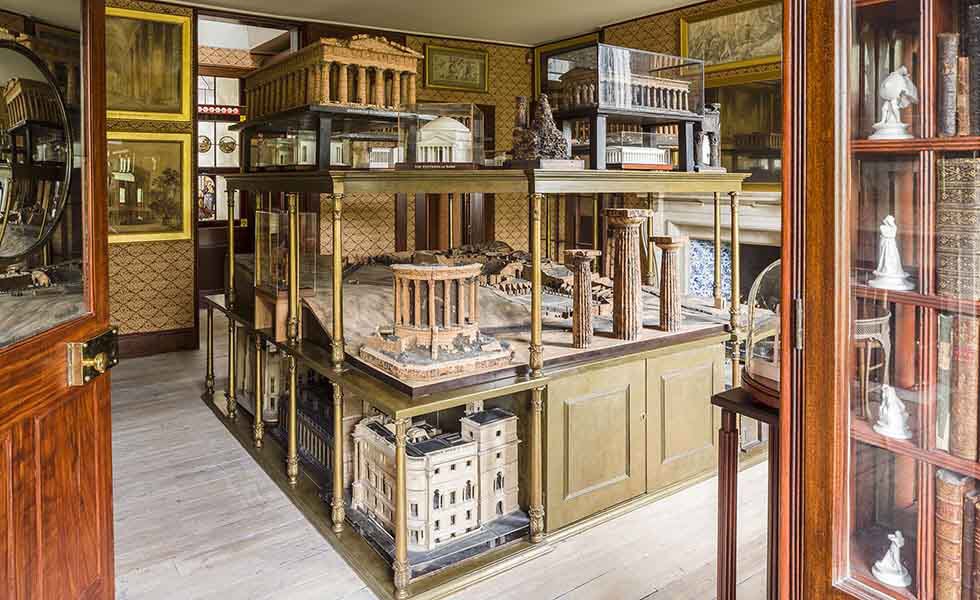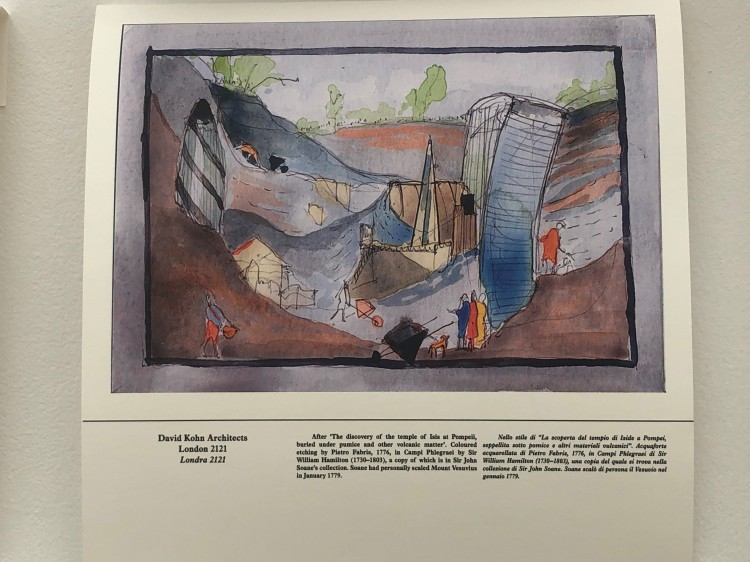




MY FAVOURITE – museum in London is the Soane Museum, located on the north side of Lincoln’s Inn Fields. This was the private home of the famous British architect Sir John Soane, who lived a long and industrious life. Soane was born in 1753 in Goring on Thames and died in London in 1837. As a young man he studied at the newly formed Royal Academy, Piccadilly and attended lectures in architecture and drawing. He won several awards for the quality of his draughtsmanship, including a Silver Medal for a detailed drawing of the Banqueting House, Whitehall. A few years later he won a Gold Medal for his design of a Triumphal Bridge. Shortly after he won a Travelling Scholarship that enabled him to embark on his own Grand Tour of Europe.
THE GRAND TOUR – From 1778-1780 John Soane travelled through Italy spending long periods in Rome, Naples and Sicily. He was fascinated by the Greek Temples at Paestum, just south of Salerno. In Rome and Naples, he studied and sketched Roman ruins and remains, he visited Vesuvius and Pompeii. In Sicily he visited Palermo, Selinunte and Agrigento, to see the spectacular Greek Temples. Further north in Bologna and Vicenza he sketched and studied numerous classical buildings, including villas by the famous architect Palladio. When he returned to London in 1780 he was thoroughly steeped in the history, culture and architecture of Italy, from Greek and Roman times, to medieval, renaissance and palladian styles.
THE PALLADIAN STYLE of classical architecture was already very popular in the British Isles. It had been introduced into Britain by Lord Burlington around 1720 and used in the construction of Burlington House on Piccadilly (later to become the Royal Academy). Having studied at the Royal Academy in the 1770s John Soane would have been very familiar with the principles of classical and Palladian architecture. During Soane’s own personal Grand Tour the young gentleman absorbed many of the details and principles of classical architecture. On his return to England in 1780 he started to build his architectural practice. It took him several years to get his first major commission for a villa-type country house called Letton Hall in Norfolk. This turned out to be the first of many commissions for the young Mr Soane. He went on to design the Bank of England, Dulwich Picture Gallery, numerous country houses and several churches.
Whilst travelling in Europe, John Soane began to amass a fascinating collection of souvenirs and mementoes; Greek and Roman casts, sculptures, amphorae, marble boxes, coins and artefacts. As his career developed and he became a wealthy man, he continued to extend his collection and to acquire paintings, furniture, porcelain and silverware to adorn his home. He even created a model room filled with scale versions of classical buildings he’d visited in Italy and Sicily. In the 1820s he purchased an Egyptian sarcophagus, a stone coffin made of alabaster, made for the Egyptian King Seti I, and dating back to 1279 BC. The story goes that Soane bought the sarcophagus as the focal point of his ‘collection’ in 1824, when the British Museum refused to pay the £2,000 price tag. Soane’s collection became an eclectic display of his own personal taste and style. A collection that filled and dominated every corner of his home. He even had to buy the houses next door to create more space.
Then in 1833, realising the importance of his collection and wanting to ensure its survival after his death, Soane managed to negotiate an Act of Parliament to guarantee that his house and collection would remain exactly as it was after his death, and effectively gifting the house to the nation, much to the disgust of his son! This act of altruism meant that Sir John Soane’s house would be preserved, as it was in the 1820s, and available for the public to view and appreciate. It has remained that way ever since 1837.
THE MUSEUM – Almost two hundred years later, as a visitor to the Soane Museum I feel as if I am walking into an original 18th century London house. This is exactly what John Soane intended. Only a small number of visitors are allowed into the house at any one time. So after a short wait outside, usually about ten minutes, visitors are invited in by a member of the museum staff. Climbing the stone steps to the front door and stepping into the small dark hall is like taking a step back several centuries. I half expected to meet Mr Soane himself, on the stairs or in the Drawing Room. My favourite room is the Breakfast Room where Soane started each day. The room is naturally quite dark, there is a single window looking onto an internal courtyard. However Soane used his design skills to create a gently domed ceiling, some top lighting and large numbers of mirrors to reflect and redistribute light. The final result is quite exceptional.

On one occasion Mr Soane gave a party at the house that lasted for three days. He invited friends, colleagues and potential customers. It is easy to imagine the guests stepping into Soane’s house and seeing the over-crowded basement, with the alabaster sarcophagus located in the centre of the space, surrounded by marble busts, sculptures, bronzes, ceramics and every conceivable architectural detail. There’s an exceptional collection of paintings too, including several by Canaletto, the most popular painter of Venice of the day. Closer to home, there are William Hogarth paintings on the walls, including eight canvases of The Rake’s Progress, telling the story of a debauched young man, living a life of parties and pleasure in 18th century London.




For me, it is a privilege to visit a private house with the contents in place and on display just as they would have been when the owner was alive. I always leave the Soane Museum feeling that I know a little bit more about life in Lincoln’s Inn and perhaps a little more of the life and motivations of Sir John Soane. In fact the trustees of the museum state on the Soane website that it is their hope that visitors, ‘….enter (the house) curious and leave inspired…’
For me this is certainly the case. Private collections, in their original location, displayed as the owner intended, are completely compelling. They give a small insight into the characters and personalities that lived there. An insight that I personally, feel delighted and honoured to have been given.
Notes:
- The highly informative Soane Museum website: The Soane Museum, London
- A similar private home museum in London is Leighton House, former home and studio of Frederick, Lord Leighton, worth a visit for its highly idiosyncratic interiors and beautiful artist’s studio on the top floor. Leighton House, London
- For a brief history of the Grand Tour that I recently wrote: The Grand Tour
- For more on the birth of archaeology as a subject: Vesuvius – volcanic eruption, Herculaneum and Pompeii
- Herculaneum – a very bright future…..
- Andrea Palladio – an Italian architect who lived in the Venice area in the 16th century was probably the most influential architect of the ‘Grand Tour Era’. He designed country houses using principles of Greek and Roman architecture.
- He also designed several Venetian churches including San Giorgio Maggiore and The Church of the Redentore on the Venetian island of Giudecca.
- Lord Burlington, whilst on the Grand Tour in the 18th century, encountered Palladio’s magnificent houses and was inspired to build Chiswick House and Burlington House in England in Palladian style. This started a stampede in Britain, amongst wealthy families to have their country homes redesigned in the so-called ‘Palladian style’.
- For numerous articles on Palladian Villas in the Veneto, why not start here: The architectural style of Palladio, Veneto, Italy





NOTE: In this year’s Biennale (Venezia) 2021 an architectural exhibit in the Belgian Pavilion references the famous excavation image (above) a copy of which is held at The Soane Museum, from the 1770s by Pietro Fabris.
- Written by Janet Simmonds www.greyhoundtrainers.com
- Specialist travel at: www.grand-tourist.com
- Published: 08-01-2018
- Updated: 12-07-2021


I love reading your articles about places I’ve been–not to the Soane Museum, but to many of the places he traveled on his Grand Tour. I, too, felt like a Grand Tourist when I toured Italy with you, Janet!
LikeLiked by 1 person